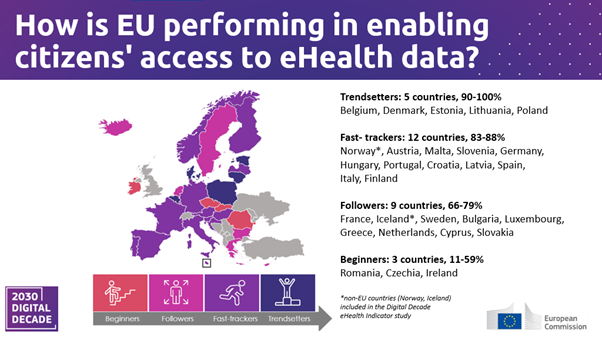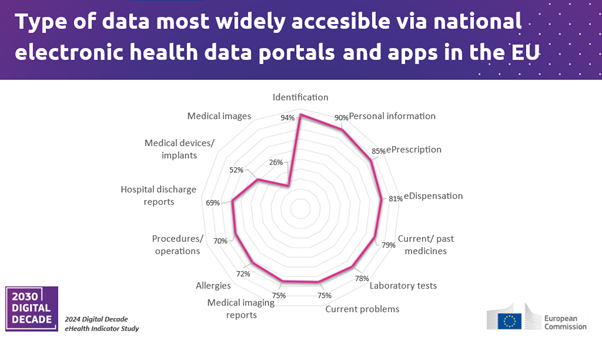
The use of health data and of digital health technologies have a great potential to improve access to health services by citizens, increase the quality and efficiency of healthcare, develop personalised approaches and support research and innovation. The Digital Decade Policy Programme 2030 is driving progress towards universal access to electronic health records for EU citizens and empowering patients through digital health.
This study has examined the progress made by EU Member States (as well as by Norway and Iceland) regarding the citizens’ access to their electronic health records. The results describe the state of play as of 31 December 2023. A composite indicator has been used for this monitoring, incorporating four layers that comprehensively analyse multiple aspects of access to eHealth records: the implementation of electronic access services for citizens, categories of accessible health data, access technology used (eID, access via portals or apps), coverage (by population and healthcare providers), and equitable access opportunities.
How is EU performing in enabling citizens' access to eHealth data?
Europe is improving its maturity on the eHealth indicator. EU27-average overall composite score increased to 79% from 72% last year. The results show that countries are progressing well in facilitating citizens’ access to electronic health records. Twenty-two Member States (81%) improved in score in the past year. The availability of different data types has improved, notably within the category of electronic results and reports, more categories of healthcare providers are connected and supplying data, and more online access services follow web content accessibility guidelines.
There are several areas for further progress. At the end of 2023, all Member States (100%) provided some form of national or regional online access service(s) for citizens to access their health data. However, there are still gaps in the population coverage, meaning that not all people can access such services. To meet the 100% target in 2030, access has to become universal. More healthcare providers, especially private ones, need to be connected to the access services, as currently the data is mostly supplied by healthcare providers from the public sector. Among the diverse selection of health data, certain data types have limited availability, especially data about medical images (26%) and medical devices/implants (52%). The full implementation of relevant legal instruments such as the eIDAS Regulation and the Web Accessibility Directive must be ensured.
Which countries enable access to eHealth data in the most complete way?
The top five most mature countries in the EU-27 are Belgium (100%), Denmark (98%), Estonia (98%), Lithuania (95%) and Poland (90%). The biggest improvement over last year was observed for France (+25 points), Portugal (+23 points), Slovakia (+20 points), and Germany (+17 points).

The picture across the four framework layers
In 2024, all Member States provide some form of national or regional online access service(s) for citizens to access their health data. Twenty-three Member States (89%) report providing access to electronic health records through a centralised access service. The remaining four Member States (Ireland, Italy, Spain, and Sweden) report having regional services.
EU-27 achieved an average score of 74% on the thematic layer for the categories of accessible health data, a growth of 10 percentage points since last year. This is the lowest-scoring thematic layer among the four layers conceptualised in the eHealth methodology, which, however, has improved the most.
The most mature categories of health data include data about identification (maturity score of 94%), personal information (90%), ePrescription (85%), eDispensation (81%), current and relevant past medicines (79%), and laboratory test results (78%). The least mature categories of data include data about medical images (26%), medical devices and implants (52%), hospital discharge reports (69%), and procedures/operations (70%). Nevertheless, 6 more countries made medical imaging reports available since last year. 17 Member States (63%) made improvements by either providing more categories of health data or providing the available data in a timely manner.

In 2024, the EU-27 average for the thematic layer about access technology and coverage reached 80%, an improvement of seven percentage points since the previous year.
Seventeen Member States (63%) enable citizens to use a secure eID (pre-)notified under the eIDAS Regulation to authenticate themselves when using the online access service. This is an improvement compared to last year when only half of EU countries had their eID (pre-)notified in compliance with eIDAS Regulation.
All Member States except Ireland offer access to electronic health data through an online portal. Only one health region in Ireland offers access to health data and does so using a native mobile application. 14 Member States (48%) report offering citizens both online portal(s) and native mobile application(s) as modes to access their electronic health records. In terms of population coverage, 20 Member States (74%) report that 80-100% of the national population can technically make use of the online access for electronic health records to view their health data. In total, 16 Member States improved their score in the field of access technology and coverage.
Public healthcare providers (72%) are better connected than private healthcare providers (55%). At the same time, the coverage of healthcare providers that are connected and supplying relevant health data is the lowest-scoring sub-indicator of this thematic layer. Only seven Member States (26%) report that at least 60% of healthcare providers across all applicable categories of facilities (e.g. primary care facilities, secondary care facilities, geriatric nursing homes, etc.) are supplying (at least some) relevant data to the access service. Nonetheless, 11 Member States (41%) expanded the number of categories of connected healthcare providers since the last year.
In 2024, the EU-27 average for the thematic layer about access opportunities increased by seven percentage points compared to previous year, reaching 77%.
Seven Member States (Austria, Belgium, Denmark, Estonia, Germany, Lithuania, and Poland) score full points: all four requirements are fully implemented for access by legal guardians, by authorised persons, providing assistance mechanisms for disadvantaged groups and compliant with WCAG v2.1 and Web Accessibility Directive.
Background info
The data was gathered in the form of a survey that took place between April and May 2024 and presents the data as of 31 December 2023. Respondents were national competent authorities.
Following the adoption of the Declaration on European Digital Rights and Principles and the Digital Decade Policy Programme 2030, agreed jointly by the European Parliament, Member States and the Commission, a comprehensive monitoring framework was developed, in close cooperation with Member States, to provide the tools to monitor and annually report the advancement towards achieving digital targets and objectives for all EU Member States to be reached by 2030 across four areas: digital skills, digital infrastructure, digitalisation of business and of public services. The eHealth target of access to electronic health records is complementing two other targets: the target of providing 100% online accessibility of key public services and the target of access to secure electronic identification (eID) for 100% of Union citizens.
The Report
Related content
Policy and legislation | 02 July 2024
The second annual report on the State of the Digital Decade takes stock of the EU’s progress towards a successful digital transformation, as set out in the Digital Decade Policy Programme 2030.
